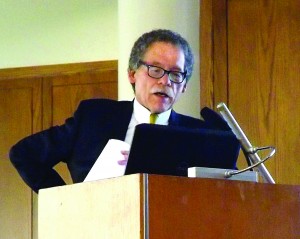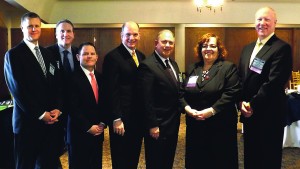
President,
The Brownstein Corporation
The Eighth Annual Education and Networking Conference was held at the Villanova University Conference Center on April 23, 2015, under the auspices of ABF Journal, the New York Institute of Credit, the Turnaround Management Association Philadelphia Chapter and the Commercial Finance Association Philadelphia Chapter. The day once again featured last year’s popular “Judicial Jeopardy” segment, along with three panels of some of the region’s top judges, lenders, factors and attorneys and rounded it out with a networking cocktail hour.
Judicial Jeopardy
Back by popular demand, “Judicial Jeopardy” — once again proved to be a rousing game, highlighting the legal (and trivial) knowledge of bankruptcy judges from the Districts of Delaware, New Jersey and Pennsylvania. Bankruptcy Judge Michael B. Kaplan of the District of New Jersey served in the role of Alex Trebek. The contestants included Judge Andrew B. Altenburg, Jr. of the District of New Jersey, Chief Judge Eric L. Frank of the Eastern District of Pennsylvania, and Chief Judge Kevin Gross of the District of Delaware.
The venerable judges fielded difficult questions on American history and bankruptcy as well as more light-hearted questions on popular television show theme songs. Several attendees remarked that this year’s bankruptcy-related questions were an order of magnitude tougher than last year. (It is rumored that the judicial contestants breathed a sigh of relief that former Judge Judith Wizmur had retired, since at last year’s conference she had virtually swept the contest with her encyclopedic knowledge of American history.)
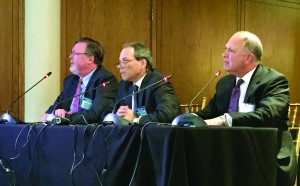
We’ve listed the questions in the Judicial Jeopardy Quiz — see how many you know!
Talking Turnarounds
The first panel program, titled “Renegades, Recalcitrants and Opportunities Throughout the Capital Structure,” focused on restructurings and turnarounds and featured Jeffrey C. Hampton, partner & co-chair of the bankruptcy and restructuring department at Saul Ewing; Vincent Belcastro, managing director/group head of corporate equipment finance at Santander Bank; Robert D. Katz, of Executive Sounding Board Associates; Michael S. Goodman, managing director, of SSG Capital Advisors and Allen Wilen, partner at EisnerAmper.
This program utilized a case study, as well as “Sudden and Second Thoughts” on how to be opportunistic. The case study involved the saga of “Winches ‘R’ Us Company,” a $100 million manufacturer and distributor of industrial and consumer-related winches, primarily for heavy-duty and standard-duty towing businesses. For example, the company’s industrial-duty winches were made for manufacturing and equipment customers, while its consumer-duty winches were made for Jeeps and alternative terrain vehicles. The company’s normal course EBITDA levels was about $10 million, and its capital structure was the result of an “ABL-light” and leveraged finance transaction that had enabled the acquisition of the company by a private equity firm. The debt structure consisted of senior debt of $60 million divided into a $20 million revolver and a $40 million term loan, which allowed the company to leverage itself to six times its senior debt, and mezzanine debt of $20 million from a specialty debt fund. These two tranches increased total debt to 8X leverage.
[caption id="attachment_37243" align="alignleft" width="300"]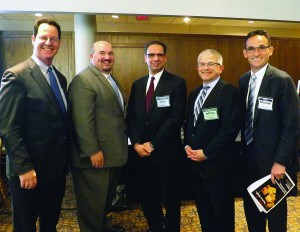
A Workout
The circumstances leading to the company winding up in workout included a failed effort to infuse additional equity. A restructuring advisor had been engaged to help raise equity for the company, but had difficulty obtaining information from the company. After heavy negotiations that lasted more than three months, the equity group declined to infuse additional equity, resulting in covenant defaults within 18 months of the deal having closed — “before the ink was dry on the documents.” After several covenant waivers within a one-year period, the lender transferred the credit to its workout group. By that point, revenue had trended down to $60 million, with EBITDA of $2 million. As a result, cash availability under the revolver was tight, with the lender maintaining control of blocked cash accounts. The company’s business continued to deteriorate, but the equity fund was not helpful in the process, and seemed mainly concerned about its own possible exposure, from a financial and credibility standpoint, and refused to inject more capital.
A distressed buyout group arrived on the scene, and after performing preliminary due diligence, offered to buy out the senior lender’s position for 60% of par value, offering to allow the mezzanine lender 10% of its par value, even though it felt that the mezzanine lender was out of the money, and of course, the legacy private equity firm was well underwater. The only alternative would be a Chapter 11 proceeding, the outcome of which would be uncertain. The senior lender was represented by an attorney whose position was, “It’s my client’s collateral,” and felt the owners should just “toss the keys” to the lenders and avoid a lot of Sturm und Drang.
The foregoing situation provided an opportunity for the panel to address such questions as:
- Who funds the turnaround: the senior lender, the mezzanine lender or equity?
- What do you do if there is a “renegade” in the group? Does the answer to this question differ, depending upon where the renegade falls in the capital structure?
- When does a lender consider taking a haircut? When is the first loss, the best loss?
- What are the obligations of the company’s board of directors in this situation?
- Should the potential debt buyer consider a loan-to-own option?
- How does your strategy change when you or your client is in or out of the money?
- How are the politics of the lender’s potential write-down handled? How much deference/time do you give to the investment banker to sell the business?
- How do you deal with a recalcitrant buyer?
- How you do deal with the dynamics of counsel and the consultants?
- What if the client recently changed?
- What was the best result you have seen in a deal involving recalcitrant and renegades? What were the pivotal points?
Then, as promised at the outset of the program, the panel turned its attention to “Sudden & Second Thoughts”:
- What are influencing factors in whether there will be recalcitrants and renegades?
- In today’s environment with pressures increasing, what factors provide hope or concern?
- Are recalcitrants and renegades becoming more the rule than the exception? If so, how does that change one’s approach or position?
- As a lender, is your first exit still the best? Is any other alternative high risk versus high reward? How do you maximize your opportunity?
EisnerAmper’s Allen Wilen commented, “Sometimes getting to a workable solution requires understanding and getting to know the individuals at the table, and what motivates them. This goes for both principals and professionals.” He found it helpful in such situations to “step into their shoes” and try to see the world as they see it, in order better to understand their viewpoint. He has seen cases where such individual “agendas” may affect the outcome, swaying a stakeholder from what logic might suggest its position should be.
Michael Goodman of SSG Capital Advisors mentioned the increasing role played by nontraditional lenders and providers of capital, especially in turnaround financing situations. He said the behavior of regulated lenders in a workout situation was somewhat predictable, whereas the newer players, like funds and BDCs, have different viewpoints, and this can potentially take outcomes in a different direction.
Session 2: Lender Case Study
The second panel program — the Lenders Panel — titled “How Different Lenders view the Same Financing Opportunity… Differently,” was moderated by Paul H. Shur, partner at Windels, Marx, Lane & Mittendorf.
This panel also used a fictional case study, “XYZ Corp,” a Delaware corporation that assembles and distributes machine parts used in sophisticated radar, surveillance and GPS applications, and which has patented metallurgical technology. XYZ, headquartered in upstate New York with a manufacturing facility located in Pennsylvania, was owned by an affiliate. XYZ’s customers included manufacturers located in the U.S. and abroad, and it purchased parts from a distributor in the UK.
XYZ’s sales per annum averaged $25 million. It maintained a sizable amount of inventory in the facility in Pennsylvania, and its A/R averaged $10 million, a rather slow collection cycle, due to collection issues and claims raised by certain high-maintenance “techie” customers. Several customers were involved in transactions ultimately involving governmental agencies and were highly secretive about their operations and business. Due to the difficulty in monitoring this highly profitable, governmentally impacted facet of its business, XYZ created a separate division to handle this business.
A family-owned business dating back to the 1950s, XYZ’s current principals, Manny, Moe and Jack, were cousins used to dealing with local banks for their financing. They had no sophisticated systems for tracking collections or financial reporting, and they had, until now, used the cash-flow from sales collections to finance product development and to pay for parts. Demand for increased production was affecting cash-flow, and the company had been unprofitable for the previous two years, despite a favorable track record until then. Consultants had suggested more sophisticated financing to take advantage of the company’s goodwill, business prospects and assets, to afford it the working capital to grow.
[caption id="attachment_37249" align="alignleft" width="300"]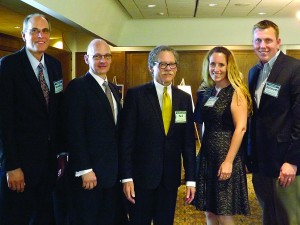
Unique Perspectives on the Same Opportunity
The panelists, consisting of a factoring company, a nonregulated asset-based lender and two regulated bank asset-based lenders, had a different view of XYZ’s situation and the lending opportunity it presented. The viewpoint of the regulated bank lenders reflected the competitiveness of the current market for financing, and interest in providing financing for the current asset collateral: A/R and inventory, as well as the machinery and equipment, and possibly even the intellectual property, which was not valued on the company’s balance sheet, but could nonetheless be appraised. Brad Weaver of Webster Business Credit commented that he’d like to “do the whole thing.”
However, the regulated lenders referred to the importance of the due diligence; what the bank would have to do to confirm asset values and the apparent slowness in collection of certain accounts receivable. And of course, there was the matter of the company’s losses in recent years, which would make this more of a collateral-based loan, with less reliance on cash-flow. The principals would, no doubt, have to guarantee the debt personally. Particularly because of the history of losses, there would also likely be restrictions on payments to the founder on the buyout, depending upon how the company was doing.
The nonregulated lender expressed more flexibility regarding the lending formula for the current assets and less sensitivity about the slowness of collection, but was less interested in the machinery and equipment lending, and not at all in the intellectual property, although it would nonetheless be pledged along with “all assets.” Similarly, the factoring panelist was focused on the current assets, and there was mention of possible dilution in the accounts receivable if the high-maintenance customers created a lot of invoice adjustments or returns. The factoring panelist also mentioned the possibility that if the borrower’s customers were ultimately government agencies (which was hinted at but not explicit spelled out in the case), that might furnish an additional source of comfort in the collateral.
Views from the Bench
The final panel program, “Views from the Bench: Insights from Bankruptcy Court Judges and Leading Bankruptcy Attorneys,” featured Judge Rosemary Gambardella of the District of New Jersey, and Chief Judge Brendan L. Shannon and Judge Kevin Gross, both of the District of Delaware. The panel was moderated by Mark S. Indelicato, partner at Hahn & Hessen, and included attorney panelists Sean Beach, partner at Young Conaway Stargatt & Taylor; Andrew Silfen, partner at Arent Fox and Mark Minuti, partner at Saul Ewing.
The panel focused on a few recent and notable bankruptcy cases, about which the judges and attorneys on the panel were quite knowledgeable, and in which some of them had been involved. The Asarco and Fisker cases provided an opportunity to discuss fee issues and the right of secured lenders to credit-bid their liens, including whether allowing credit bidding chills a sale process, and whether time spent by a law firm defending its fee application should be billable. In Asarco, what was originally filed as a liquidating plan, became a “100-cent” plan, whereby all creditors were paid in full through realization of a large fraudulent conveyance claim, which the debtor had not intended to pursue.
[caption id="attachment_37253" align="alignleft" width="300"]
The recent Caesars case involved an involuntary bankruptcy filing by one set of stakeholders intent on preserving an avoidance claim for the estate, competing with a voluntary filing by the debtor in a different jurisdiction. It raised interesting questions about “bad faith” filings, venue choice and the fiduciary duties of officers and directors.
The day concluded with a networking cocktail reception in the Montrose Mansion, where attendees caught up with old friends and colleagues and talked about the industry over drinks. All in all, the conference proved to be a productive day for attendees.
[caption id="attachment_37242" align="alignleft" width="300"]
Judicial Jeopardy Quiz
1. This Bankruptcy Code section enumerates expenses and claims that have priority, in the order in which they are listed.
2. This term is defined first under Bankruptcy Code §101(1).
3. Section 727(a)(1) provides that the Court shall grant a Chapter 7 debtor a discharge unless the debtor is ____.
4. Section 523(a)(17) makes these debts nondischargeable for prisoners.
5. This Code section provides redemption for the individual debtor.
6. This Code section is titled, “Who may be a Debtor.”
7. This subsection provides a list of what property of the Estate does not include.
8. Section 705 allows for the election of ___ at a §341(a) meeting of creditors.
9. Section 101(9) explicitly excludes this type of partnership from the definition of the term “corporation.”
10. Distribution on account of punitive damage claims is expressly subordinated to other unsecured claims by this Code section.
Answers to Bankruptcy Questions
1. What is §507?
2. What is “accountant”?
3. What is “not an individual”?
4. What are Court-imposed fees and costs?
5. What is §722?
6. What is §109?
7. What is §541(b)?
8. What is a creditors’ committee?
9. What is a “limited partnership”?
10. What is §726(a)(4)?
Howard Brod Brownstein is president of The Brownstein Corporation, a turnaround management and distressed M&A firm, and is a contributing editor of ABF Journal.

